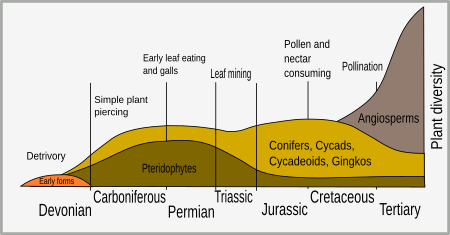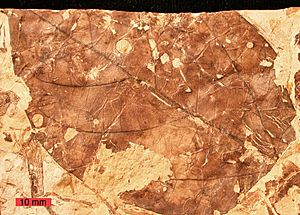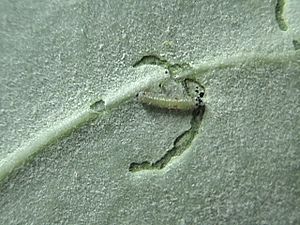Defence against herbivory facts for kids
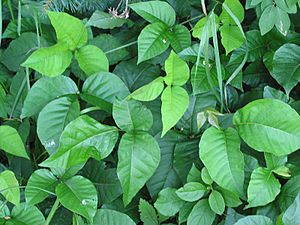
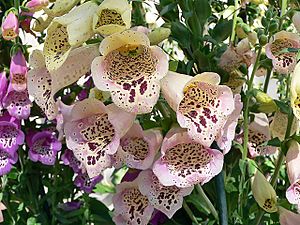
Have you ever wondered how plants protect themselves from being eaten? Plants can't run away from animals that want to munch on them, so they have developed amazing ways to defend themselves. This is called defence against herbivory. It's all about how plants stay safe from herbivores, which are animals that eat plants. These special ways help plants survive and make more plants.
Many plants create special chemicals. These chemicals can change how herbivores act, grow, or even survive. Some chemicals act like a "keep out" sign, pushing herbivores away. Others are like a secret weapon, making the plant hard to digest or even poisonous to the animals that eat them. Some plants are super special; they can store heavy metals from the soil, which are toxic to animals. These plants are called hyperaccumulators.
Plants also get help from other animals! Some plants invite the natural enemies of herbivores to live nearby. For example, some plants provide a home for ants, and these ants will fiercely defend the plant from other insects.
Plants use other clever tricks too. They might grow in places where herbivores can't easily find them or reach them. Or they might grow only when herbivores aren't around. Sometimes, plants can trick herbivores into eating parts that aren't important, or they can simply grow back quickly after being nibbled.
Plant defenses can be one of two types:
- Constitutive defenses are always there, like a plant's built-in shield.
- Induced defenses are created only when the plant is attacked or stressed by herbivores. Plants are smart and can react to damage!
For a very long time, insects have been the main plant-eaters, especially young insects called larvae. Plants and insects have grown and changed together over millions of years. Most plant defenses are aimed at insects, but some plants have also developed ways to protect themselves from bigger herbivores like birds and mammals.
Learning about how plants defend themselves is important. It helps us understand how life on Earth has changed over time. It also helps us in agriculture, like growing food for people and animals, by understanding how plants naturally protect themselves.
Contents
Plant Chemicals: Nature's Pharmacy
Plants have developed chemicals that affect insects, but some of these chemicals can also affect bigger animals, including humans. Many medicines we use today come from the chemicals plants make to protect themselves. Think about opium, aspirin, and atropine – these all come from plants!
For example, some plants make chemicals called pyrrolizidine alkaloids. These are a defense against insects. Scientists have found over 660 different types of these chemicals in more than 6,000 plants! About half of them can harm the liver, which is why it's important to be careful around unknown plants.
How Plant Defenses Evolved
The first plants to grow on land appeared about 450 million years ago, during a time called the Ordovician period. These early plants were simple and needed water to reproduce. Later, about 400 million years ago in the Devonian era, more complex plants called Vascular plants appeared. These plants had special features like protective coatings to stop them from drying out.
To spread in dry places, vascular plants developed special seeds. Then, during the Cretaceous period, flowering plants (angiosperms) grew and spread very quickly. At the same time, there was a huge burst of new insect species. This rapid growth of insects was a big challenge for plants, pushing them to develop new ways to defend themselves. Early insects mostly bit or chewed plants. But as vascular plants evolved, insects also developed new ways to eat, like sucking sap, mining inside leaves, forming galls (strange growths on plants), and feeding on nectar. This back-and-forth change between plants and insects is called co-evolution.
Ancient Evidence of Plant-Eating
How do we know about ancient plant-eating? We look at three main things:
- Fossilized plants: These can show signs of defense, like spines, or damage from insects.
- Fossilized animal poop: Called coprolite, this can contain bits of plants that animals ate.
- Insect mouthparts: The shape of fossilized insect mouths tells us how they ate plants.
Scientists used to think that plant-eating was mostly a thing of the Mesozoic Era (the age of dinosaurs). But now we know it happened much earlier! Within 20 million years of the first plant fossils appearing in the Silurian period (around 420 million years ago), there's evidence that plants were being eaten. Animals ate the spores of early Devonian plants. Fossils from a place called the Rhynie chert show that some creatures used a "pierce and suck" method to feed on plants. Many plants from this time also had spine-like growths, which might have been for defense.
Over the next 75 million years, plants developed more complex parts like roots and seeds. It took 50 to 100 million years after each new plant part evolved for animals to start eating it. We see signs of insects making holes in leaves and eating only the soft parts (skeletonization) in the early Permian period. By the end of that period, insects had also started sucking fluids from plant surfaces.
Co-evolution: A Plant-Animal Dance
Herbivores need plants for food, so they have also evolved special ways to get that food, even with all the plant defenses. These adaptations in herbivores are like "offensive traits" – they help them eat and use host plants better. The relationship between herbivores and their host plants often leads to a back-and-forth evolutionary change, which is called co-evolution.
When a herbivore eats, it tends to eat plants that don't have strong enough defenses. This gives plants that can defend themselves a better chance to survive and reproduce. So, plants with good defenses become more common. When the changes in both the plant and the herbivore are directly caused by each other, we say they have co-evolved.
One idea, called "escape and radiation," suggests that these adaptations in herbivores and plants have been a major reason for new species forming. These adaptations played a big role in the huge variety of insect species that appeared during the time of flowering plants. Some clever herbivores have even found ways to use plant defenses to their own advantage! They can store these plant chemicals and use them to protect themselves from their own predators.
Plants Need Animals Too!
Even though many plants strongly defend their leaves, most of them still need animals for other important things. For example, up to 98% of flowering plants in tropical rain forests rely on animals for pollination (moving pollen to help them reproduce) and seed dispersal (spreading their seeds to new places).


